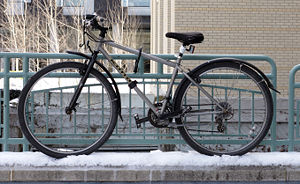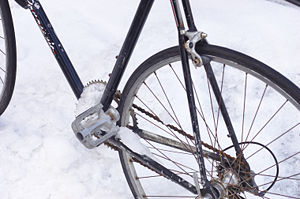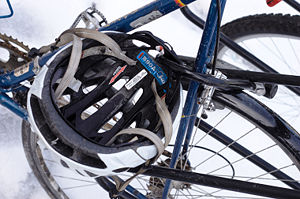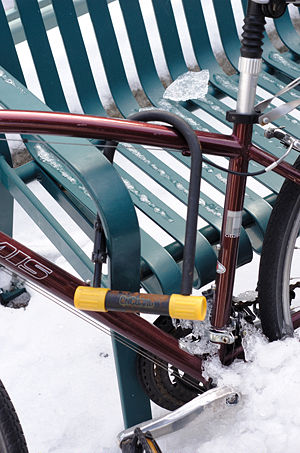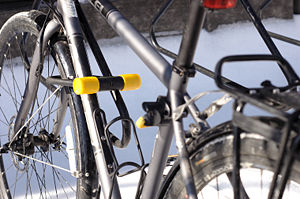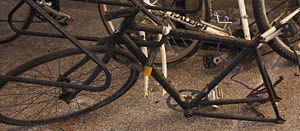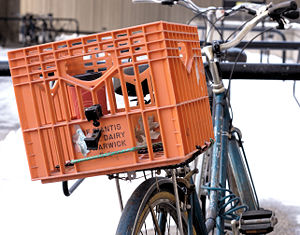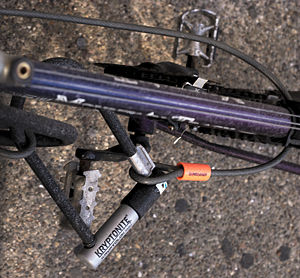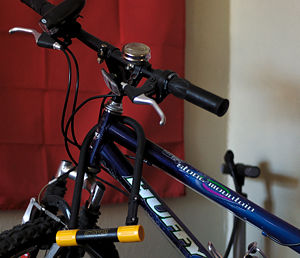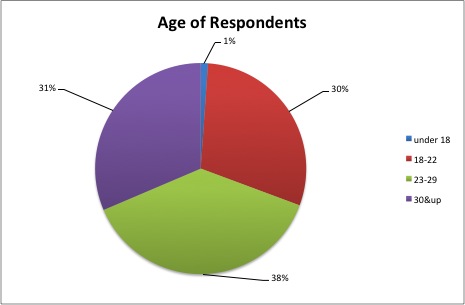Bike lock opportunity
From DDL Wiki
(→References) |
(→Market Research) |
||
| Line 5: | Line 5: | ||
= Executive Summary = | = Executive Summary = | ||
= Market Research = | = Market Research = | ||
| - | |||
| - | |||
| - | |||
| - | |||
| - | |||
| - | |||
| - | |||
| - | |||
| - | |||
| - | |||
| - | |||
| - | |||
| - | |||
=== Observational Studies === | === Observational Studies === | ||
| Line 61: | Line 48: | ||
Carnegie Mellon Cycling Team/Club | Carnegie Mellon Cycling Team/Club | ||
:To get more informed comments and suggestions regarding bike locks and accessories, we contacted Carnegie Mellon’s Cycling Team and Club. Because they regularly ride bicycles and are more knowledgeable on the subject of bicycles, we thought that talking with them would be beneficial. When conversing with them we asked them to give their comments and suggestions about bike locks and other bike accessories, bike accessories that should exist but don’t yet, and the bike itself. What we learned is that they, just like the rest of the population who took the survey, have the same complaints and suggestions regarding bike locks. They want a bike lock that is more portable and has a better carrying attachment, does not scratch the bike frame, and is lighter but still strong and secure. They also informed us of two bike locks, the TiGr Lock and Hiplok, that work well. The TiGr Lock is a lightweight titanium bicycle lock that is long enough to lock both wheels and the frame [1]. The Hiplok is a fabric covered chain lock that can be carried by the rider’s hips while cycling [2]. We learned that in addition to a standard cable or U-Lock, they also used locking skewers. Most bikes today are equipped with quick release front and back wheels and seats, meaning that they are easy targets when not locked. Locking skewers replace the quick release wheel and seat skewers to prevent theft of these items. Each skewer has its own uniquely shaped nut and a matching key so a standard wrench would not be able to loosen the nut [3]. When hearing their comments about other existing bike accessories we learned that they felt that there is room for improvement in multiple areas. The comments and suggestions we received for this area include: mounting tires is a pain, work stands and storage for bikes could be improved, the integration of turn and brake signals into bike locks, a higher factor of safety on helmets, an improved attachment system for panniers, and a solar powered bike light. When asked to come up with a bike accessory they would want that does not exist, we received suggestions such as, a bike dashboard, heated handlebars, and a car horn for bikes. Finally, we asked them if there could be any improvements done to the bicycle itself. The only suggestion we received was to design an anti-lock braking system to prevent the brakes from locking up and skidding. | :To get more informed comments and suggestions regarding bike locks and accessories, we contacted Carnegie Mellon’s Cycling Team and Club. Because they regularly ride bicycles and are more knowledgeable on the subject of bicycles, we thought that talking with them would be beneficial. When conversing with them we asked them to give their comments and suggestions about bike locks and other bike accessories, bike accessories that should exist but don’t yet, and the bike itself. What we learned is that they, just like the rest of the population who took the survey, have the same complaints and suggestions regarding bike locks. They want a bike lock that is more portable and has a better carrying attachment, does not scratch the bike frame, and is lighter but still strong and secure. They also informed us of two bike locks, the TiGr Lock and Hiplok, that work well. The TiGr Lock is a lightweight titanium bicycle lock that is long enough to lock both wheels and the frame [1]. The Hiplok is a fabric covered chain lock that can be carried by the rider’s hips while cycling [2]. We learned that in addition to a standard cable or U-Lock, they also used locking skewers. Most bikes today are equipped with quick release front and back wheels and seats, meaning that they are easy targets when not locked. Locking skewers replace the quick release wheel and seat skewers to prevent theft of these items. Each skewer has its own uniquely shaped nut and a matching key so a standard wrench would not be able to loosen the nut [3]. When hearing their comments about other existing bike accessories we learned that they felt that there is room for improvement in multiple areas. The comments and suggestions we received for this area include: mounting tires is a pain, work stands and storage for bikes could be improved, the integration of turn and brake signals into bike locks, a higher factor of safety on helmets, an improved attachment system for panniers, and a solar powered bike light. When asked to come up with a bike accessory they would want that does not exist, we received suggestions such as, a bike dashboard, heated handlebars, and a car horn for bikes. Finally, we asked them if there could be any improvements done to the bicycle itself. The only suggestion we received was to design an anti-lock braking system to prevent the brakes from locking up and skidding. | ||
| + | |||
| + | === Survey Results === | ||
| + | Through the survey, we asked people about the type of bike lock they use, how and where they lock their bikes, basic demographic information about themselves, and asked them for anything they wish was different about their bike lock or other available products. We determined that most people use a U-lock, or a U-lock and a cable in combination so that they can lock more parts of their bike at once. Even then, many questioned the security of existing locks and wished that they were easier to carry, lighter, and more secure. In general, nearly everyone polled said that they lock the frame of their bike, with extra locking measures or better locks being able to also lock one or both wheels as well as the frame. The exception to this was with international respondents, where they were more likely to use a lock that while it would prevent the bike from being ridden away would not prevent someone from picking up the bike and walking away with it. | ||
| + | |||
| + | '''Respondents''' | ||
| + | |||
| + | By splitting into age ranges, we found that our respondents fit fairly evenly into 3 age groups, one from 18-22, one from 22-29, and one 30 & above. The majority of respondents are daily riders from urban areas, and came from 9 countries around the world, although primarily US residents. The most important contributions from out survey are summarized in the graphs below. | ||
| + | |||
| + | [[Image:graph1.jpg]] [[Image:graph2.jpg]] | ||
| + | |||
| + | |||
| + | |||
| + | |||
| + | [[Image:graph3.jpg]] [[Image:graph7.jpg]] | ||
= Design Ideas = | = Design Ideas = | ||
Revision as of 20:40, 23 February 2014
I am the Batman
Contents |
Executive Summary
Market Research
Observational Studies
We went around Carnegie Mellon's campus and into University of Pittsburgh's campus and studied how users locked up their bikes. We were able to notice many interesting things, listed below.
The main takeaways of this study are:
- Users have come up with ways to deal with shortcomings of locks, such as combining lock types or attaching a milk crate.
- Bike transmissions are not very weatherproof and require a lot of maintenance that people do not typically do.
- Few people use the provided mounting bracket to store their lock on their bike. Some designs will not fit every bike.
- People will lock their bikes to anything available that is secure enough.
Expert Interviews
ProBikes
- Commonly sold bike was a Hybrid bike: a mix between a mountain and a road bike. Useful as a daily commuter and casual riding. Most popular accessory was lights by far. Most uncommon item or difficult to find item was a rear derailleur hanger. This is because there are many different types and styles. There is no standard so year, brand, and frame geometry all factor into what type of rear derailleur hanger you need.. Biggest complaint with bikes relates to shifting gears. Chains either are not lubricated, over lubricated, rusted, or they mis-shift. This generally falls on the user of the bike because they do not maintain their bike drivetrain properly. Maintenance issues were usually due to mileage, but the biggest mileage independant wear item was tires. Flat tires always happen and people come in asking for help with that. Maintenance items are tire levers, which help remove the tire from the hub, and inner tubes for tires. People are still afraid of using these by themselves though, so they have the shop do it for them. Generally stolen items are seatposts and lights. Usually people don’t seem to take tires anymore, mostly the whole bike. The guys at the shop said they wanted a lightweight and easy to carry lock that was still super secure.
Locksmith (Locksmith was out on call, but someone else in the store helped me)
- Most of their work comes from replacing keys in old (100+ year old) houses. At this point it seems some lock components wear out. Generally, the locksmith only gets about 3 calls a year about bike locks and usually just cuts them with bolt cutters, if possible. Picking a bike lock is rarely done, at least by this place. The most secure type of lock is made by a company called Mul-T lock. They are apparently undrillable, unpickable, and if you break a key in them, you must replace the whole door. There are smaller variants of this type of lock. The key is really weird looking and damn near impossible to machine easily and you have to call the company with a special number to verify that you are the owner of the lock if you need a replacement key. The store’s hint for environmental protection was to spritz some WD-40 (no joke) into your lock every once in a while. It’ll flush out dirt and grime and not leave a residue. Also helps prevent freezing.
Stakeholder Interviews
Carnegie Mellon Cycling Team/Club
- To get more informed comments and suggestions regarding bike locks and accessories, we contacted Carnegie Mellon’s Cycling Team and Club. Because they regularly ride bicycles and are more knowledgeable on the subject of bicycles, we thought that talking with them would be beneficial. When conversing with them we asked them to give their comments and suggestions about bike locks and other bike accessories, bike accessories that should exist but don’t yet, and the bike itself. What we learned is that they, just like the rest of the population who took the survey, have the same complaints and suggestions regarding bike locks. They want a bike lock that is more portable and has a better carrying attachment, does not scratch the bike frame, and is lighter but still strong and secure. They also informed us of two bike locks, the TiGr Lock and Hiplok, that work well. The TiGr Lock is a lightweight titanium bicycle lock that is long enough to lock both wheels and the frame [1]. The Hiplok is a fabric covered chain lock that can be carried by the rider’s hips while cycling [2]. We learned that in addition to a standard cable or U-Lock, they also used locking skewers. Most bikes today are equipped with quick release front and back wheels and seats, meaning that they are easy targets when not locked. Locking skewers replace the quick release wheel and seat skewers to prevent theft of these items. Each skewer has its own uniquely shaped nut and a matching key so a standard wrench would not be able to loosen the nut [3]. When hearing their comments about other existing bike accessories we learned that they felt that there is room for improvement in multiple areas. The comments and suggestions we received for this area include: mounting tires is a pain, work stands and storage for bikes could be improved, the integration of turn and brake signals into bike locks, a higher factor of safety on helmets, an improved attachment system for panniers, and a solar powered bike light. When asked to come up with a bike accessory they would want that does not exist, we received suggestions such as, a bike dashboard, heated handlebars, and a car horn for bikes. Finally, we asked them if there could be any improvements done to the bicycle itself. The only suggestion we received was to design an anti-lock braking system to prevent the brakes from locking up and skidding.
Survey Results
Through the survey, we asked people about the type of bike lock they use, how and where they lock their bikes, basic demographic information about themselves, and asked them for anything they wish was different about their bike lock or other available products. We determined that most people use a U-lock, or a U-lock and a cable in combination so that they can lock more parts of their bike at once. Even then, many questioned the security of existing locks and wished that they were easier to carry, lighter, and more secure. In general, nearly everyone polled said that they lock the frame of their bike, with extra locking measures or better locks being able to also lock one or both wheels as well as the frame. The exception to this was with international respondents, where they were more likely to use a lock that while it would prevent the bike from being ridden away would not prevent someone from picking up the bike and walking away with it.
Respondents
By splitting into age ranges, we found that our respondents fit fairly evenly into 3 age groups, one from 18-22, one from 22-29, and one 30 & above. The majority of respondents are daily riders from urban areas, and came from 9 countries around the world, although primarily US residents. The most important contributions from out survey are summarized in the graphs below.
Design Ideas
Competitor Analysis
Pugh Chart
Team Roles
Final Concepts
Gantt Chart
Appendix
100 Ideas
References
1. <http://tigrlock.com/>
